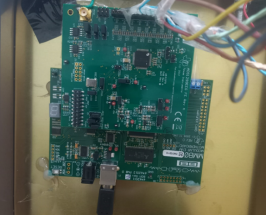The integration of brain-computer interfaces (BCIs) in neuroscience has opened new avenues for understanding and interpreting neural signals. This study focuses on the analysis of frequencies and amplitudes in detecting neural signals, particularly through the conversion of these signals into digital formats. Initially, we acquired a BCI device (MSOP-8EVM and MSOP-8EVM-PDK) and examined its architecture and operational principles. Following this, we fabricated electrodes from copper plates, chosen for their excellent conductivity, to capture signals from muscular tissues. Our preliminary experiments revealed a significant presence of noise, which hindered our ability to analyze the desired neural signals effectively.
Introduction to brain-computer interface
Brain-computer interfaces (BCIs) represent a transformative technology that enables direct communication between the brain and external devices by interpreting neural activity. The ability to accurately detect and analyze neural signals is crucial for the development of effective BCI systems. This research investigates the role of frequency and amplitude analysis in enhancing signal detection capabilities within BCIs.
In our study, we began with an extensive review of existing literature on BCI technologies, focusing on their design principles and signal processing methodologies. The initial phase involved acquiring a BCI device and understanding its components, including the signal acquisition hardware and processing algorithms. We then designed custom electrodes using copper plates due to their superior conductive properties, which allowed for efficient capture of electrical activity from muscle tissues.
Learning objectives
The aim of this study is to enhance the detection and analysis of neural signals through the application of brain-computer interface (BCI) technology. By focusing on the analysis of frequencies and amplitudes, we seek to improve the clarity and reliability of neural signal interpretation, which is crucial for advancing BCI applications in various fields such as rehabilitation, neuroprosthetics, and cognitive neuroscience.
This research addresses the persistent challenge of noise interference that often complicates the extraction of meaningful data from neural signals. We hypothesize that by implementing innovative methodologies, including environmental control measures, we can significantly reduce background noise and improve signal quality. The study emphasizes the importance of signal processing techniques, such as filtering and wavelet transforms, in isolating relevant frequency ranges associated with neural activity.
MSOP-8EVM and MSOP-8EVM-PDK board
The MSOP-8EVM (Evaluation Module) and MSOP-8EVM-PDK (Product Development Kit) are specialized evaluation boards designed for testing and evaluating single-channel, 14- to 16-bit analog-to-digital converters (ADCs) housed in an MSOP-8 package.

Fig. 1. Overview of the MSOP-8EVM (Evaluation Module) and MSOP-8EVM-PDK (Product Development Kit)
The MSOP-8EVM serves as a versatile platform for evaluating various ADCs. Key features include:
Full-featured Evaluation Board: The MSOP-8EVM is designed to support a wide range of single-channel ADCs, enabling users to assess the performance and characteristics of different devices.
Onboard Reference and Buffer Circuits: This board includes integrated circuits that provide stable reference voltages and buffering, essential for accurate signal conversion.
High-Speed Serial Interface: The EVM supports high-speed data transfer, which is crucial for applications requiring rapid signal processing.
Modular Design: The modular nature of the MSOP-8EVM allows it to be easily integrated with various digital signal processors (DSPs) and microcontroller interface boards, making it adaptable for different project requirements.
In our research, we designed a specialized experimental setup to investigate neural signals effectively while minimizing external noise interference. A key component of this setup was a metal mesh enclosure, which served as a noise suppression chamber. This innovative design allowed us to isolate the subject from external electromagnetic disturbances, thereby enhancing the quality of the recorded signals. The noise suppression chamber was constructed using a sturdy metal mesh, which acted as a Faraday cage. This design principle is based on the ability of conductive materials to block electromagnetic fields, effectively reducing noise that could corrupt our data collection. The enclosure was spacious enough to comfortably accommodate a student from our research group, who volunteered to participate in the experiment. Inside the chamber, the student was seated in a relaxed position to ensure minimal movement during the experiment. This positioning was crucial, as even slight movements could introduce additional noise into the recordings. The interior of the chamber was designed to be as comfortable as possible, allowing the subject to focus on the task at hand without distractions. To capture electrical signals from muscular tissues effectively, we connected custom-designed electrodes to the student's forearm. The electrodes were made from high-conductivity copper plates, which were carefully placed on specific muscle groups to ensure optimal signal acquisition.
Placement: The electrodes were positioned strategically on the forearm to target muscles that would generate clear and distinguishable signals during contraction.
Connection Process: Each electrode was securely attached using medical-grade adhesive pads, ensuring good contact with the skin while minimizing discomfort for the participant. The connections were double-checked for stability and reliability before commencing data collection.
Conclusion
The exploration of brain-computer interfaces (BCIs) represents a significant advancement in our understanding of neural signal processing and its applications in various fields, including rehabilitation, neuroprosthetics, and cognitive neuroscience. Throughout this study, we have addressed critical challenges associated with the detection and interpretation of neural signals, particularly focusing on muscle activity captured through innovative experimental methodologies.
References:
- Alcaide-Aguirre, J. M., & Gutiérrez-Garrido, A. (2017). Brain-computer interfaces: Current applications and future directions. Journal of Neural Engineering, 14(5), 1–12. https://doi.org/10.1088/1741–2552/aa8c0b
- Aricò, P., et al. (2016). EEG-based brain-computer interfaces for improving human performance: A review. IEEE Transactions on Human-Machine Systems, 46(4), 507–517. https://doi.org/10.1109/THMS.2016.2547038
- Bashashati, A., Fatourechi, M., Ward, R. K., & Birch, G. E. (2007). A survey of signal processing algorithms in brain-computer interfaces. Journal of Neural Engineering, 4(2), R32-R57. https://doi.org/10.1088/1741–2560/4/2/R01

